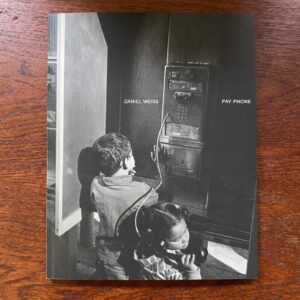JTF (just the facts): Published in 2018 by Kominek Books (here). Hardcover, 100 pages (unpaginated), with 9 color and 22 black and white photographs. Aside from a list of first names (which represents the models with whom the artist collaborated), there are no texts or essays included. In an edition of 500 copies. Design by Florence Meunier. (Cover and spread shots below.)
A special edition of the book (here) includes a signed and numbered print. It is available in an edition of 25 copies.
Comments/Context: The portraits of young women found in the Swiss photographer Senta Simond’s new photobook Rayon Vert deliver an unexpected viewing experience – they simultaneously feel both old and new, as if oscillating back and forth between two very different states of being.
To say her pictures look old is, in this case, a particular kind of compliment. Her up close faces and gentle twisted gestures recall the works of some of the medium’s finest makers, and a deliberate flip through the pages of Rayon Vert evokes a stream of photographic allusions and visual echoes that go back a century or more.
Her inspired use of shadows to decorate and bisect bodies and her attention to the ripple of ribs or the washing out of an expression brings to mind some of Man Ray’s experimental and surreal nudes and portraits from the 1920s and 1930s. And her more intimate (and inverted or off-angle) views of faces and skin connect to the female-driven Modernism of Imogen Cunningham and Florence Henri of the same period, as well as the intense attention of Paul Strand’s images of his wife Rebecca or Edward Weston’s portraits of Tina Modotti. Her photographs feel rooted in an educated and observant understanding of what has come before, without falling into the trap of direct emulation.
Simond’s photographs are equally new and of the moment in that they smartly renegotiate the relationship between photographer and model. While it is impossible to say whether the subjects of these pictures are friends, peers, students, or simply hired models, the collaborative relationship between taking place between the artist and sitter is obvious. Gone are the awkward power games and indirectly lascivious desires of the male gaze, replaced by a clear and attentive engagement, full of easy going comfort and respect.
Many of Simond’s best images are constructed from layers of stacked arms and legs, where angular piles of knees and elbows carve up space and jutting limbs play with sculptural depth. But even when the camera goes underneath, or overhead, or someplace else unexpected and perhaps intimately personal, there is never the sense that these are abstract, anonymous bodies being blithely chopped up and arranged by an omniscient artist (a charge we might have leveled at quite a few Modernist portraitists and female nude makers). These are people, and a cleverly designed list in the back of the book gives first names to fourteen different subjects. And in every single image in the book, a real life face is an integral part of the composition, reinforcing the pattern of private familiarity.
What comes through strongly in Simond’s images is a consistent sense of personal warmth. While these young women are alternately vulnerable, quiet, introspective, and open in front of the camera, smiles regularly appear, reminding us that there is genuine companionship and shared experience embedded in this process of art making. These are portraits of women taken by a thoughtful woman, and they have a noticeably different (and more contemporary) atmosphere that surrounds and permeates them. Simond notices tumbling hair, and skin (often with a fine coating of downy fluff), and tiny variations in expression that flutter across faces like wind (even when the eyes are closed), and the implicit trust and intimacy found in these interactions gives the pictures their bedrock authenticity, even when Simond may be toying with intricate photographic arrangements like surreal reversed angles, unexpected planes of focus, or carefully cast shadows. And although many of the pictures might be characterized as nudes, the models are never fully naked – skin is boldly revealed, but always in the context of being partially clothed, ensuring the subjects are always safe and comfortable with the proceedings.
With just one exception, all of Simond’s photographs are vertically oriented, so it would have been understandable if she had opted for a fairly straightforward photobook design, where individual images were set on spreads in a rhythmic fashion. But between the alternating use of color and black and white, the movement back and forth between the left side and the right side, and to a lesser extent, the use of slightly smaller images, a predictable flow is repeatedly broken up. The most unusual design element found here is the liberal use of entirely blank spreads, a total of 16 such white/white pairings that interrupt the images and force the viewer to slow down. The result is photobook that never lets us settle into a state of dull non-attention – the changing placement of the images keeps us guessing, and that uncertainty makes the arrival of each picture something to savor. I realize that this simple, understated feature might seem unimportant, but it noticeably alters the experience of the photographs without being intrusive or distracting.
It requires understated care to produce photographs with such consideration and refinement, and Simond has clearly taken the time necessary to engage each of her sitters with patience and contemplation. The resulting photographs, and their thoughtful presentation in Rayon Vert, draw from a deep wellspring of genuine partnership, where risks are taken by both artist and model and outcomes with durable vitality are created.
Collector’s POV: Senta Simond is represented by Webber Gallery in London (here). Her work has little secondary market history at this point, so gallery retail remains the best option for those collectors interested in following up.

























